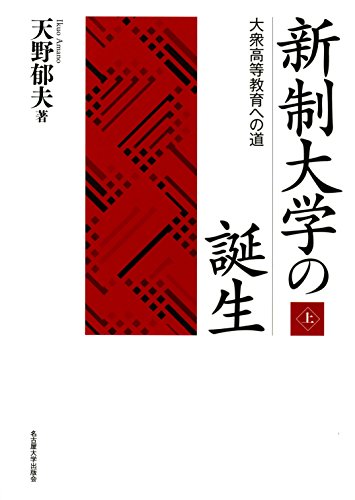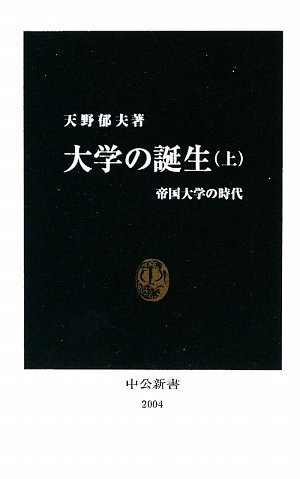3 0 0 0 OA 高等教育研究・私史
- 著者
- 天野 郁夫
- 出版者
- 日本高等教育学会
- 雑誌
- 高等教育研究 (ISSN:24342343)
- 巻号頁・発行日
- vol.20, pp.157-176, 2017-07-31 (Released:2019-05-13)
- 参考文献数
- 13
この度日本高等教育学会から,学会創立20周年行事の一環として学会設立当時の状況や設立の背景や学会の現状について,初代学会会長として一文を寄稿するような依頼があった.学会設立の事情を語るには,高等教育研究の制度化の源流に遡って見ていく必要がある. 私が高等教育研究に関心を持ったのは,1960年代の初め,東京大学大学院の教育社会学専攻に在籍していた頃からである.当時,高等教育研究は,細々とやられていたにすぎなかった. 学会創設以前の高等教育研究に大きな役割を果たしたのは,大学史研究会,IDE文献研究会,広島大学・大学教育研究センター(現高等教育研究開発センター)などである.特に1972年のセンターの創設は,エポックメイキングな出来事であった. その後,マス化の進展とともに顕在化し始めた,高等教育の新しい政策課題に対応するため,文部省は国立教育研究所に高等教育研究室を置いたほか,大学入試センター(1976),放送教育開発センター(1978),学位授与機構(1991),国立学校財務センター(1992)など,次々に大学関連のサービスセンターを開設し,そこに調査研究関連の部局を置いた.さらに国立大学に大学教育関連のセンターが順次設置され,私立セクターでも,同様のセンターを設ける大学が現れ始めた.また1980年代の後半になると,玉川大学出版部が高等教育関連の本を,積極的に刊行し始めた. 東京大学教育学部にようやくわが国最初の「高等教育論講座」の新設が認められたのは1992年,私が初代の教授に就任した. このように高等教育学会の創設に至る,私が体験してきた高等教育研究の流れと時代状況の変化をたどってみると,1990年代半ばという時代が,その機が熟したというべきか,様々な条件と環境が,学会の設置に向けて整い始めた時代であったことがわかる. 1997年9月には東京大学で発会式を迎えることになった.私たちからみれば新世代の高等教育研究者たちの熱意と努力の賜物である.教育社会学の関係者が多いとはいえ,多様な専門分野から理事が選出され,他の教育関連諸学との関係が深まった.高等教育研究者の集まる「アゴラ(広場)」の出現である. その後,2010年から11年にかけての『リーディングス 日本の高等教育』の刊行は時代の「激流」に巻き込まれ,「あわただしく」対応を迫られてきた高等教育研究に対する「批判的反省と学問的な問い直し」の試みという点で,重要な意味を持っている. 今世紀に入ってからの新自由主義的な政策誘導の高等教育改革という高等教育研究を取り巻く状況の激変は,研究者に期待される専門性の内容が大きく変化し,その幅が著しく拡大したことを示唆している.改革は具体的な実践の問題になった.そのことが例えば学会の年次大会における研究発表の,また会員の出身専門分野のどのような変化をもたらしているのか.20周年を迎えた学会が,「批判的自省」を踏まえた「さらなる発展と飛躍」をはかるためにも,改めて検証する必要があるだろう.教育社会学以外のどのような学問的・理論的よりどころをもとに知識と理解を深めていくのか,学会は今それを問われているといってよい. 世代交替の進んだ学会が主導的に,研究の新しいフロンティアを切り開いていくことを期待している.
3 0 0 0 歴史のなかの非常勤講師 (今月のテ-マ 非常勤教員を考える)
- 著者
- 天野 郁夫
- 出版者
- IDE大学協会
- 雑誌
- IDE (ISSN:03890511)
- 巻号頁・発行日
- no.381, pp.45-53, 1996-10
2 0 0 0 OA 教育の地位表示機能について
- 著者
- 天野 郁夫
- 出版者
- 日本教育社会学会
- 雑誌
- 教育社会学研究 (ISSN:03873145)
- 巻号頁・発行日
- vol.38, pp.44-49, 1983-10-20 (Released:2011-03-18)
- 被引用文献数
- 2
- 著者
- 天野 郁夫
- 出版者
- 一般社団法人 日本教育学会
- 雑誌
- 教育学研究 (ISSN:03873161)
- 巻号頁・発行日
- vol.76, no.2, pp.172-184, 2009-06-30 (Released:2017-11-28)
高等教育システムはいま、世界的な変動期を迎えている。日本もその例外ではない。そのシステム変動の基本的な構造と方向性を分析する上で、最も説得的な理論とされているのは、アメリカの社会学者マーチン・トロウの「歴史・構造理論」である。「エリートからマス、ユニバーサルへ」の段階移行で知られるこの理論は、ヨーロッパ、それにアメリカ高等教育の発展の歴史的な経験をもとに、一般化されたものである。本論文の目的は、日本の経験を事例に、その比較高等教育システム論としてのトロウ理論の妥当性を検証することにある。日本を、ヨーロッパ・アメリカと対比させた本論文での分析は、この移行理論の基本的な妥当性を裏付けるものである。しかし同時に、その移行過程の分析は、「エリートからマス、そしてユニバーサルへ」の段階移行に、単一の道を想定することの妥当性に疑問を提示するものである。移行の過程について、アメリカ、ヨーロッパ、そして日本に代表される東アジアという、3つの道を想定することによって、この理論はさらに説得性を増し、実り多いものになるはずである。
2 0 0 0 新制大学の時代 : 日本的高等教育像の模索
2 0 0 0 高等教育機関の設置認可と基準判定-1-
- 著者
- 天野 郁夫
- 出版者
- 名古屋大学教育学部
- 雑誌
- 名古屋大學教育學部紀要 教育学科 (ISSN:04657748)
- 巻号頁・発行日
- no.22, pp.p85-97, 1976-03
- 著者
- 天野 郁夫
- 出版者
- 広島大学
- 雑誌
- 大学研究ノート (ISSN:02876612)
- 巻号頁・発行日
- vol.30, pp.1-45, 1977-06
2 0 0 0 OA 高等教育に関する文献解題
- 著者
- 天野 郁夫 新井 郁男
- 出版者
- 日本教育社会学会
- 雑誌
- 教育社会学研究 (ISSN:03873145)
- 巻号頁・発行日
- vol.26, pp.122-136, 1971-10-10 (Released:2011-03-18)
1 0 0 0 OA 日本の高等教育研究 回顧と展望
- 著者
- 天野 郁夫
- 出版者
- 日本高等教育学会
- 雑誌
- 高等教育研究 (ISSN:24342343)
- 巻号頁・発行日
- vol.1, pp.7-27, 1998-05-30 (Released:2019-05-13)
- 参考文献数
- 28
- 被引用文献数
- 6
In Japan, higher education research as an independent field of study had its “take-off” phase in the 1970’s. The massification of higher education, student revolt in the end of the 1960’s, and the rapid development of higher education research in the U. S. were the main forces that prompted the “take-off”. After a rather gradual growth in the 1980’s, the field experienced rapid expansion in the 1990’s. In the movement towards structural readjustment of Japanese economy, politics and society. Universities and colleges were forced to change drastically in their basic concept, organizational structure and functions. In response to the pressure, the Ministry of Education relaxed substantially the University Establishment Standard on undergraduate education in 1991. Stimulated by the initiative, many of the universities and colleges started to reorganize not only their curricula but also basic structures of teaching, research and administration. The rapid development of higher education reform prompted an expansion of higher education research. Even though research and training units in the field of higher education is still limited in number, researchers interested in the field have been increasing rapidly. The research topics have become increasingly diversified, and many are related to policy or practice than genuinely academic. In 1997, the first academic and comprehensive research society on higher education was established with more than 300 members. Higher education research is expected to grow more rapidly in the coming decade.
1 0 0 0 OA 高等教育の構造変動
- 著者
- 天野 郁夫
- 出版者
- 日本教育社会学会
- 雑誌
- 教育社会学研究 (ISSN:03873145)
- 巻号頁・発行日
- vol.70, pp.39-57, 2002-05-15 (Released:2011-03-18)
- 参考文献数
- 24
- 被引用文献数
- 3 2
In the 1990s, Japanese higher education underwent the largest structural changes since the 1940s, when it was forced to carry out drastic reform under the American occupation. In spite of the post-war reforms modeled after the US, Japanese higher education maintained its traditionally rigid, uniform, and hierarchical structure for more than half a century. In the beginning of the 1970s, there was a major rise in the movement to reform higher education, with the aim to shake and change its long established structure. However, because of the strong resistance from universities and professors, the Ministry of Education failed to carry out its reform plan.At the end of 1980s, there was another big surge in the movement reform Japanese higher education. And this time, the universities and professors criticized as conservative for a long time, started positively to tackle the difficult tasks.Behind these changing attitudes, we can point to several important factors compelling reform. First, there were three international “megatrends” : i.e.(1) massification, (2) marketization, and (3) globalization. Secondly, there were three national factors:(1) demographic, (2) economic, (3) policy-related factors.Under the pressure of these forces and quickened by the policies of the Education Ministry based on reports of the University Council, reforms and changes were carried out, ranging from the structure of the total system to the inside of the individual universities. Reforms at the institutional level started from undergraduate education, and various “tools” developed by American universities to improve education for massified students were introduced.Nearing the end of the 1990s, the universities began to be asked to drastically change their organizational structure, including the traditional chair-faculty system. This system, modeled after the German university, had long been considered the stronghold of academic freedom and autonomy by Japanese professors. The structural changes in Japanese higher education will reach their final phase when the universities succeed in obtaining professors' approval to replace the long established chairfaculty system with the American department-college system, and in creating new independent administration systems.
1 0 0 0 新制大学の誕生 : 大衆高等教育への道
1 0 0 0 七帝大物語(第6話)高等学校(2)自治・自由と人間形成
1 0 0 0 OA 高等普通教育と社会階層
- 著者
- 天野 郁夫
- 出版者
- 日本教育社会学会
- 雑誌
- 教育社会学研究 (ISSN:03873145)
- 巻号頁・発行日
- vol.41, pp.5-23, 1986-10-15 (Released:2011-03-18)
- 参考文献数
- 32
- 著者
- 天野 郁夫
- 出版者
- 放送大学
- 雑誌
- 研究報告 (ISSN:09152202)
- 巻号頁・発行日
- vol.67, pp.8-37, 1994-03
1 0 0 0 OA 教育の地位表示機能について
- 著者
- 天野 郁夫
- 出版者
- 日本教育社会学会
- 雑誌
- 教育社会学研究 (ISSN:03873145)
- 巻号頁・発行日
- vol.38, pp.44-49, 1983-10-20








